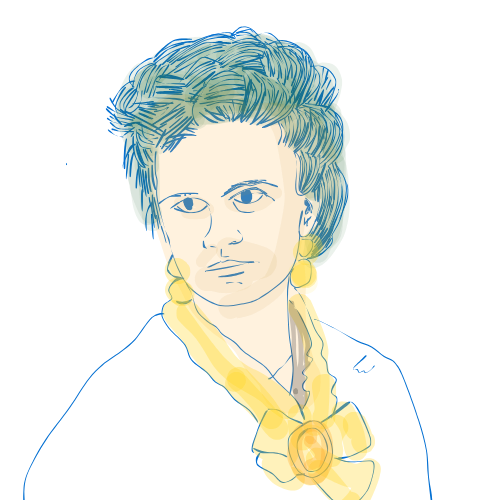바베뜨는 아랫동네에 사는 이모집에 놀러가고 싶어하지만 할머니는 무화과가 여물 때까지 기다리라고 한다. 아직도 작고 단단한 무화과를 바라보며 바베뜨는…
하지만 따스한 비가 내리고 강렬한 햇볕이 쨍쨍 내리쬐자, 성모상처럼 참을성 있던 마망네넨과 벌새처럼 가만있지 못하던 바베뜨 둘 다 어느새 뜨거운 여름이 왔다는 사실을 깨달았다. 바베뜨는 울타리를 따라 길게 심어져 있는 무화과나무들 앞에서 매일 춤을 추었다. 바베뜨는 나무 아래로 느릿느릿 걸으며, 옹이 사이에 뻗어나온 나뭇가지들을 주의 깊게 살펴보았다. 하지만 나무를 살필 때마다 그녀는 늘 울적한 마음만 들었다. 하지만 거기서 바베뜨는 마침내 무언가를 발견했고, 그것은 하루 종일 그녀를 노래하고 춤추게 만들었다.
1892년 2월 26일 집필한 작품으로 1893년 《보그Vogue》 8월 19일자를 통해 발표되었습니다. 이 짧은 콩트는 노인과 아이가 경험하는 시간 사이에 얼마나 큰 격차가 있는지 느끼게 해줍니다.
Ripe Figs
Maman-Nainaine1 said that when the figs were ripe Babette might go to visit her cousins down on Bayou-Boeuf, where the sugar cane grows. Not that the ripening of figs had the least thing to do with it, but that is the way Maman-Nainaine was.
It seemed to Babette a very long time to wait; for the leaves upon the trees were tender yet, and the figs were like little hard, green marbles.
But warm rains came along and plenty of strong sunshine; and though Maman-Nainaine was as patient as the statue of la Madone, and Babette as restless as a humming-bird, the first thing they both knew it was hot summer-time. Every day Babette danced out to where the fig-trees were in a long line against the fence. She walked slowly beneath them, carefully peering between the gnarled, spreading branches. But each time she came disconsolate away again. What she saw there finally was something that made her sing and dance the whole day long.
When Maman-Nainaine sat down in her stately way to breakfast, the following morning, her muslin cap2 standing like an aureole about her white, placid face, Babette approached. She bore a dainty porcelain platter, which she set down before her godmother. It contained a dozen purple figs,3 fringed around with their rich, green leaves.
“Ah,” said Maman-Nainaine, arching her eyebrows, “how early the figs have ripened this year!”
“Oh,” said Babette, “I think they have ripened very late.”
“Babette,” continued Maman-Nainaine, as she peeled the very plumpest figs with her pointed silver fruit-knife, “you will carry my love to them all down on Bayou-Boeuf. And tell your tante Frosine I shall look for her at Toussaint4–when the chrysanthemums are in bloom.”
Note
- Maman Nainaine: 마망은 프랑스어로 ‘할머니’라는 뜻. 바베뜨는 손녀다. ↩︎
- muslin cap: 모슬린 재질로 만든 모자. 19세기 여자들이 집에서 썼다. ↩︎
- Fig: 무화과. 익으면서 보라색을 띤다. ↩︎
- Toussaint: 뚜쌍. tous(all)+saint(saint)라는 뜻으로 유명한 성인뿐만 아니라 ‘모든 성인’을 기념하는 날이다. 결국 죽은 자들을 모두 추모하는 날로, 흔히 ‘만성절’로 번역된다. 만성절은 11월 1일로 가톨릭세계에서는 정숙한 축일이자 중요한 명절로 여겨진다. 4세기까지 거슬러올라가는 만성절의 전통은 이날 새벽 죽은자들이 깨어난다는 미신을 서양인들에게 심어주었다. 만성절을 모티브로 한 작품중 하나가 바로 에디스 니스벳의 사람크기 대리석상이다. 죽은자가 살아난다는 미신은 미국 등 몇몇 국가에서 할로윈Halloween(만성절 전야)으로 변질되어 전세계로 퍼지고 있다. ↩︎
Ripe Figs
written by Kate Chopin





다양한 전자책 플랫폼에서 찾아볼 수 있습니다.


최나래
이화여자대학에서 건반악기와 피아노교수법을 전공하였다. 책과 영어, 음악과 발레를 사랑하며, 혼자 있는 시간에 에너지를 얻는다. 현재는 두 아이를 키우며 엄마라는 자리에 익숙해져가고 있다.










